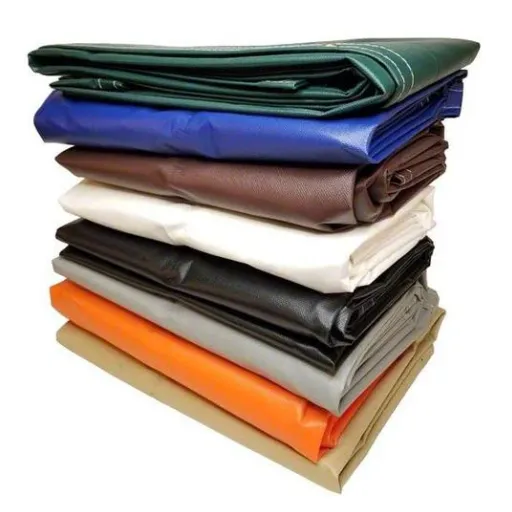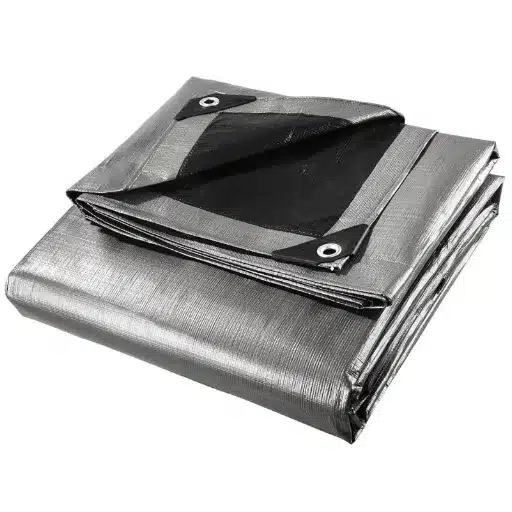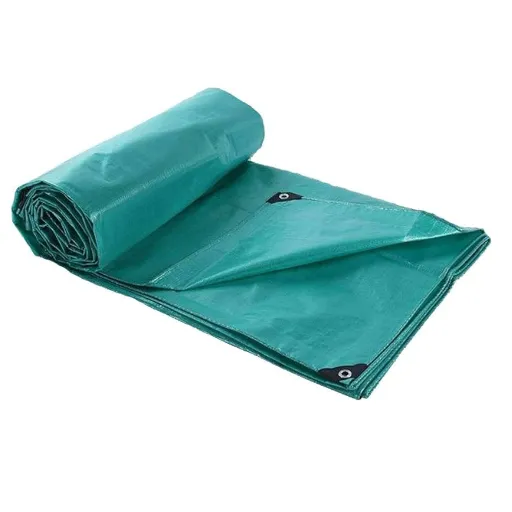Waterproof tarps are indubitable tools that provide protection from various weather conditions for residential and industrial applications. They provide good value for friends and family camping during heavy rains, hiding machinery on a construction site, or hiking through forests; the right tarp could be a game changer. Nevertheless, not every product has the same performance features, durability, and design which bring about a huge difference in selecting the one that meets your particular requirements. This guide goes extensively into the field of heavy-duty waterproof tarps discussing their predominant characteristics, durability factors, along with selecting the most suitable one for your needs. Prepare to discover all that you need to know in order to reach a well-informed choice and to get the most out of your tarp investment’s lifespan.
Understanding Waterproof Tarps
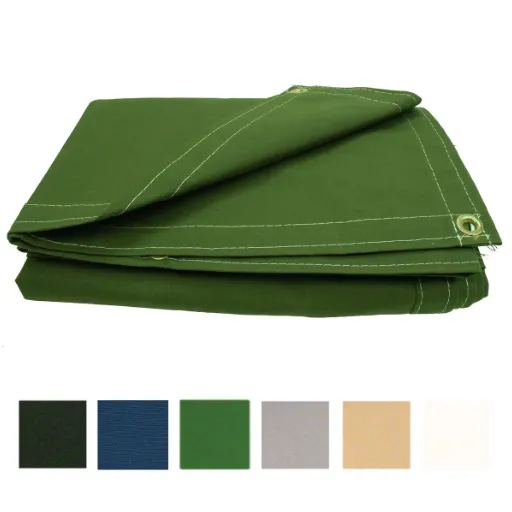
What is a Waterproof Tarp?
A waterproof tarp is a strong and flexible covering material which does not allow water to pass and which also protects water or other harsh weather conditions from getting through to the belongings or areas. The materials used for making waterproof tarps are polyethylene, vinyl, or canvas with waterproof coatings and they are treated specially with waterproof coatings that still allow the tarps to breathe. Their use has become widespread in the fields of construction, outdoor events, and transport, where the dangers of rain, snow, and other elements are always present, to protect the equipment, and furniture, or that space from being affected. The waterproof technology ensures a dependable barrier, hence the tarps are indispensable tools in residential and industrial applications.
Key Features of Heavy Duty Tarps
Durability and Strength
Heavy-duty tarps are made to be very strong and tough and can even last under the worst conditions, their tear and abrasion resistance being exceptional among others. Heavy-duty tarps are made powerful so that they can take a lot of wear and tear even in the toughest settings of industrial or outdoor use.
Waterproof and Weather-Resistant
These tarps are made to provide protection not only against water but also UV rays and harsh weather elements like snow, wind, and rain. The application of waterproof coatings and the use of UV inhibitors do not only extend the tarp’s life but also keep the tarp’s effectiveness even under severe exposure.
Versatile Usage
Heavy-duty tarps can be used in different sectors such as construction, agriculture, and even for transport and leisure. Their usefulness makes them ideal for equipment covering, ground covers or even temporary shelters.
Reinforced Edges and Grommets
Heavy-duty tarps are having reinforced hems and rust-resistant grommets which means that they can be securely fastened or tied down, making sure that they would not be blown away even in case of strong winds or heavy rain.
Resistance to Rot and Mildew
The treated materials used in these tarps resist rot, mildew, and mold growth, making them suitable for long-term outdoor storage or moisture-prone environments.
Customizable Sizes and Thickness
Heavy-duty tarps are available in a variety of sizes, colors, and thicknesses and can be customized according to the needs, thus providing a solution for both small and large applications.
Benefits of Using Waterproof Tarps
Waterproof tarps provide unmatched protection to prevent water damage and therefore, are considered to be necessary in different uses. In addition to making the area safe from moisture, they actually do prevent it, thus securing proper storage of items, construction sites, vehicles, as well as outdoor furniture, during heavy rains or snow. As they are durable it guarantees their use for a long time, even in extreme weather, thereby eventually saving one from mending the damage or buying new ones. Besides, waterproof tarps are lightweight and handy, which means they are quickly set up in case of emergencies. Presently, due to the advancement in material technology, the tarps have UV resistance and improved flexibility, i.e., they are effective even during prolonged exposure to sunlight or varying temperatures. Ultimately, waterproof tarps become a practical and economical solution for both the industries and the everyday users.
Materials and Construction of Heavy-Duty Tarps
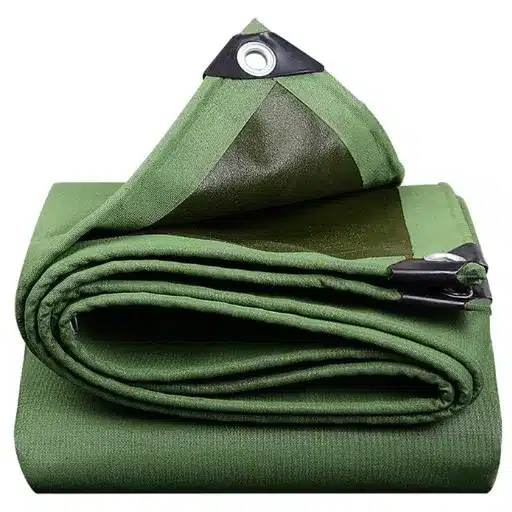
Common Materials Used in Heavy Duty Tarps
The main sources of heavy-duty tarpaulins are robust and resistant materials that can bear rough and extreme environmental conditions mostly the polyethylene, vinyl, and canvas. Polyethylene tarpaulins sometimes have a woven core inside which adds strength and makes them lightweight, completely waterproof, and tear-resistant making them perfect for outdoor usage for a long time ahead. Vinyl tarps have resistance to strong forces and abrasion, chemicals, and UV rays which makes them a preferred choice for industrial and construction works. Breathable canvas tarpaulins made from natural or synthetic fibers also have durability but they are still capable of providing ventilation to the equipment or the buildings that they are being used for protection. When these materials are combined together with precision manufacturing methods, they all make the tarps strong enough to last even during the hardest season, be loaded with much weight and still be handled frequently.
Understanding Mil Thickness in Tarps
Mil thickness is one of the most important factors when choosing a tarp, for it determines the strength of the material, its durability and suitability for a specific application. A “mil” is a measuring unit that corresponds to one-thousandth of an inch (0.001 inch), and the thickness of the tarps is usually within the range of 5 mils to 30 mils. For example, light tarps that measure around 5 to 10 mils are only good for temporary application or places where the weather is not too extreme, like covering outdoor furniture. The heavy-duty tarps, such as those 20 mils or more, are ideal for industrial or permanent usage since they already offer extreme weather protection and are capable of large demands. Knowing mil thickness not only helps in choosing a tarp that will last and fit the performance requirements but also makes the selection of the tarp’s purpose an easy task.
UV Resistant and Water-Resistant Properties
UV resistance and water-resistance are major characteristics when it comes to tarp selection but especially for outdoor usage. UV-resistant tarps are made in such a way that they can stay in the sun for longer periods without going through any sort of damage such as degrading, cracking, or fading. This kind of protection is very important when keeping items that are outdoors since they are the ones affected by the ultraviolet rays harshly as well as the tarp itself so it becomes a win-lose situation. On the other hand, water-resistant tarps are built in such a way that water cannot get into them, thus no leakages will occur and no humidity-related damage will be experienced even during rain or very humid conditions. All in all, these qualities applied to the tarp will ensure its maximum protection, which is exactly what the nature of this kind of purchase was about, whether in sunshine or rainfall it will be the same thing, so it is a good idea to use the tarp all year round. In case you are looking for a resistant solution, give priority to the UV and water-resistant tarps as only these will provide you with long-lasting and dependable performance amid different environmental hardships.
Uses of Waterproof Tarps
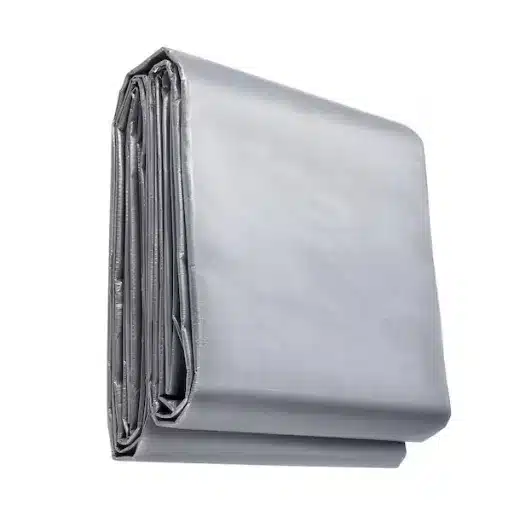
Common Applications for Heavy Duty Tarps
Heavy-duty tarps have different functionalities and are considered a must-have in many industries and daily use. Below are some of the primary uses of heavy-duty tarps:
🏗️ Construction Sites
Heavy-duty tarps are a regular sight on construction sites, where they are employed to keep the materials, tools, and the workers out of the rain, wind, and sun. Thus, tarp guarantees a regular flow of construction activities by providing rain, wind, and sun shelter.
🌾 Agriculture and Farming
Heavy-duty tarps are the best friend of farmers, who use them as protectors over hay, machines, and crops, as tarps protect them from moisture, UV radiation, and harsh weather. They also make it possible to have a temporary storage area.
🚚 Transportation
Heavy-duty tarps are also widely used for cargo transport as a means of securing and covering the load. Thanks to their heavy-duty construction, the goods are well protected from dust, debris, and unfavorable weather conditions during transit.
⛺ Recreational Use
Heavy-duty tarps are indispensable accessories for camping, hiking, or outdoor gatherings as they can serve as ground covers, tent covers, or emergency shelters. They play a big role in protecting the equipment and providing comfort in wilderness areas.
🚨 Emergency Protection
They are of great help in emergency scenarios, e.g., when storms or natural calamities occur, they become temporary roof coverings, protect the buildings that are the worse hit, and assist in the containment of debris.
🏭 Industrial Use
Heavy-duty tarps are employed in the manufacturing and shipping industries to cover the raw materials, machinery, and finished products that are in storage or transit.
Key Takeaway: The range of applications for heavy-duty tarps goes from professional requirements to personal projects; their practicality and durability become evident, thus making them an indispensable tool in different situations.
Using Tarps for RV Protection
Using heavy-duty tarps for RV protection is an efficient and economical solution to guard your RV against destructive forces and wear. Tarps work as a shield for the RV against sun, rain, snow, and dirt, thus protecting the exterior and increasing the vehicle’s life cycle. A recent study reveals that there is an increasing interest in protective covers as seen in the search trends, where a lot of the users are looking for tips on how to avoid moisture buildup and damage from extending the sun’s exposure. To ensure the best protection it is crucial to pick a tarp that is sturdy, waterproof, and ultraviolet resistant. Besides, tying the tarp securely with ropes or bungee and good ventilation will eliminate the likelihood of moisture condensation which is the primary cause of mold or mildew. The application of the right maintenance practices along with tarps, will make a year-round solution that is reliable for RV owners who have a desire to keep their RV in top condition.
Alternative Uses for Waterproof Tarps
Waterproof tarps are very adaptable and their usefulness is not limited to protecting your RV. As per the latest search engine data, here are some of the trending alternative uses for waterproof tarps:
- Emergency Shelter – Waterproof tarps are often used as temporary shelters during camping or emergency situations. Their strength and water resistance make them perfect for quickly setting up a cover against rain or wind.
- Ground Cover – Tarps can be used to cover the ground when you are outside to keep the tents or personal items from getting wet or muddy. This application is very common among campers and hikers.
- Backyard Shade Solution – Many people put up waterproof tarps in their backyards to make shady areas by hanging them across the patio or garden to block off the harmful UV rays and keep the place cool.
- Transport Protection – It is quite common to use tarps to cover the stuff being transported in trucks or trailers, thus protecting them from water, dust, and other environmental factors.
- Pool Cover – If people have swimming pools, waterproof tarps can be a low-cost alternative to dedicated pool covers, as they help to keep the water clean and reduce evaporation.
- Construction and Renovation – Tarps are often found on construction sites to secure materials and tools against rain or bad weather or to act as temporary walls and roofs during renovation work.
- Rainwater Collection – Waterproof tarps can be arranged to collect and discharge rainwater, thus supplying irrigation and emergency water storage in the areas where water conservation is critical.
The versatility and strength of waterproof tarps make them a necessity in the daily life of people and for specialized tasks as well.
Choosing the Right Waterproof Tarp
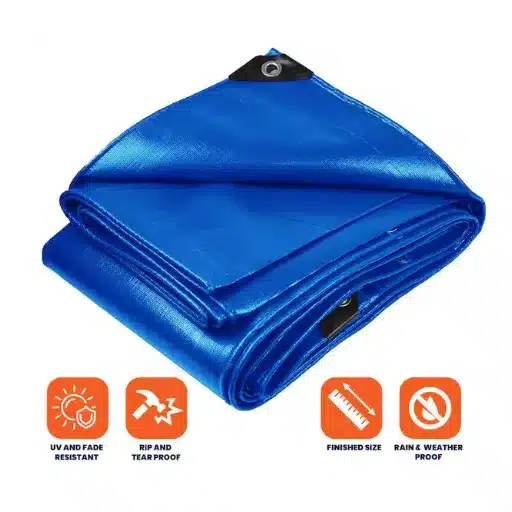
Factors to Consider When Buying a Tarp
Selecting a waterproof tarp is not merely a matter of a sturdy covering, but it involves in-depth considerations of various aspects before the right one can be chosen, all of which will certainly meet your particular needs very well:
1. Material Type
Polyethylene, vinyl, or canvas are among the materials that the tarp manufacturers usually utilize. Polyethylene tarps are the lightest and the cheapest, by contrast, vinyl tarps are the most durable and resistant to extreme weather conditions. Canvas tarps, on the other hand, are not waterproof but rather breathable, thus can be applied in some specific areas.
2. Size and Coverage
Gauge the tarp size in relation to the area that needs to be covered. It is always better to have a tarp that is slightly bigger than what is required for better coverage and secure fastening.
3. Thickness and Durability
The mil thickness of the tarp is a reference to its durability. Tarps rated 10-20 mils are the thickest, thus they are great for heavy applications; meanwhile, thin tarps are specified for light jobs.
4. Waterproofing and UV Resistance
The tarp must be totally waterproof and provide UV protection if it is going to be in the sun for long periods. Tarps that are UV-resistant can be a barrier against deterioration and thus can be a factor elongating their life span.
5. Grommet Spacing and Reinforcement
Evaluate the strength of grommets and their spacing along the tarp’s border. The presence of reinforced edges and well-positioned grommets ensures a firm installation and the reduction of wear and tear over the years.
6. Intended Use
Lastly, get to know the work that you have to do. If the use is for construction, then heavy tarps might be needed whereas, for camping and covering equipment, lighter portable options could be enough.
💡 Pro Tip: By analyzing these factors and rating quality over price, you can select a waterproof tarp that will definitely be of the required durability and performance for your application with no fear.
Comparing Sizes: Tarp 20×30 and More
The tarp size comparison from the commonly used 20×30 tarp, on the one hand, and the other, includes the intended use and the dimensions as well. The 20×30 tarp has 600 square feet of coverage that evokes its adoption for larger areas like building site protection, vehicle and boat covering, or constructing temporary shelters. When it comes to smaller-scale applications such as private camping or equipment covering, it would be more efficient and manageable to go with 10×12 or 12×20 sizes.
A research done recently shows that a lot of users have similar questions like “which tarp size will serve their needs the best?”. The responded is that the discussion must take into account the required coverage, handling convenience, and project criteria. For example, while a 20×30 tarp provides a lot of space, it could still be the wrong size for projects of a smaller scale, where smaller and lighter tarps might even be more efficient and cost-effective. Always ensure that the size of the tarp corresponds to the difficulty of the task for the best results and the least waste of material.
Importance of Metal Grommets in Tarps
Tarps are improved tremendously in terms of both durability and utility by the presence of metal grommets that are considered one of the main features of tarps. A lot of buyers are not sure about their interest and whether they should focus on grommeted tarps according to the latest search patterns. However, the response is obvious—metal grommets give secure points of contact for ropes, cords, or bungee straps, which allow the users to pull the tarp tight and keep it from being blown away or crushed under the weight of the load. Moreover, grommets facilitate the even distribution of stress over the tarp thus reducing the probability of tearing and other types of damage. In the case of projects that need extensive outdoor exposure or heavy-duty use, it is advisable to choose tarps with high-quality metal grommets that are rust-resistant so that you can be sure to get durable and reliable performance.
Maintenance and Care for Tarps
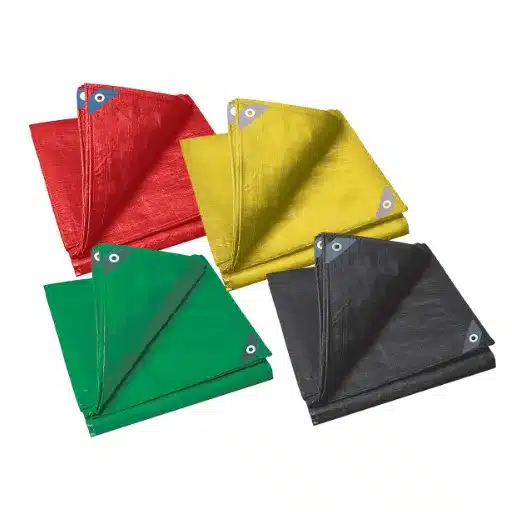
Cleaning and Storing Your Waterproof Tarp
Waterproof tarp has a longevity and an effectiveness that are directly proportional to proper cleaning and storage practices. Cleaning the tarp is best done when moisture is still present; so, rinse it with a hose or wipe with mild soapy water. Harsh chemicals and abrasive tools should not be used as they can ruin the waterproofing layer. After the tarp is washed, let it dry completely, as otherwise, during storage mold or mildew might develop on it. Next, fold it neatly and place it in an area that is cool and dry, far from sunlight and extreme temperatures, which can slowly degrade the material of the tarp. Putting tarp in a storage bag or container can be an extra measure to safeguard it from dust and pests. Thus, after going through these procedures, your waterproof tarp will be in perfect condition and ready for next use.
Quick Cleaning & Storage Tips:
- Rinse with hose or use mild soapy water
- Avoid harsh chemicals and abrasive tools
- Let dry completely before storage
- Store in cool, dry area away from sunlight
- Use storage bag for added protection
Repairing Small Damages in Heavy Duty Tarps
Heavy-duty tarps have small damages, like tears or holes, that are often easy to fix, thereby prolonging their life and maintaining their usability. Begin the process by washing the damaged spot with soap and water until it is entirely clean of dirt, debris, or grease. When it is dry, you can stick a strong adhesive patch on it or use tarp repair tape, which is available in hardware stores.
For larger rips, you can try sewing the damaged areas with heavy-duty thread and covering the stitches with waterproof sealant to make the repair stronger. Heat-seal techniques, utilizing a heat gun to attach the repair materials, can also be used for the polyethylene tarp. Always repair your tarp with the methods and products that are made for the material your tarp is for the best outcome.
Recent search patterns have revealed the curious minds of many users who ask about the use of tarp repair kits as a dedicated solution. Typically, these kits provide a complete package containing the necessary tools and materials like patches, adhesives, and instructions customized for a specific type of tarp. The technique of being prompt with small damages and using the right methods can guarantee that your heavy-duty tarp will keep on being a source of protection for many years to come.
Maximizing the Lifespan of Your Tarp
Among the most common questions posed by users who search for related topics, “How can I keep my tarp from getting deteriorated faster?” clearly emerges based on recent search statistics. To elongate the life of your heavy-duty tarp, it is crucial that the tarp is properly stored when it is not in use. Preventing unnecessary wear and tear can be done by bursting or rolling your tarp neatly and placing it in a dry and cool location. Moreover, the issue of cleanliness has been raised by many users—the use of mild soap and water for removing dirt and debris while still recommending the non-damaging is a highly acclaimed tip that is present in various guides. A further crucial factor is proper tensioning during tarp usage; if over-tightening occurs, tears are likely to happen while too much slack leads to flapping and abrasion. Lastly, periodic inspections targeted at spotting small damages early can prevent larger problems—this approach has been a primary topic in repair inquiries from users. Therefore, by employing these methods of care along with the support that has been shown in searches, your tarp can be strong and reliable for a longer time.
Frequently Asked Questions
What are the benefits of using heavy duty waterproof tarps?
Heavy-duty waterproof tarps protect from the elements and last long, making them perfect for outdoors. The main materials used for these tarps are high-quality polyethylene or polyester, which means that they can withstand the water and also prevent it from leaking in. Thickness usually measured in mil, is an important factor in the strength of these tarps; a 12 mil or 16 mil heavy-duty tarp, for example, gives better resistance to ripping and tearing. Many heavy-duty waterproof tarps also come with grommets that allow for easy securing and multiple uses. Heavy-duty tarps can be very reliable and versatile, whether for covering firewood, building a porch shelter, or doing DIY projects.
How thick should a waterproof tarp be for outdoor use?
The outdoor conditions of a waterproof tarp depend on its thickness. Tarps usually come in the thickness range of 6 mil to 20 mil, with the next two being 12 mil and 16 mil, providing excellent durability and protection. For heavy-duty uses, such as covering up vehicles or using them as protective covers for large items, it’s advisable to get a heavy-duty waterproof tarp that’s 12 mil thick or more. Besides, thicker tarps in ultra heavy-duty are less susceptible to the effects of UV rays and can last longer when exposed to the sun. The decision about how thick ultimately comes down to your project’s specific needs and how much protection you want.
What types of waterproof tarps are available on the market?
On the market there are various types of waterproof tarps to choose from based on their different applications. Heavy duty poly tarps, which are used at construction sites, and waterproof tarpaulins that are suitable for camping or outdoor activities, are among the most common types. Also available are blue tarps, which provide good visibility and come at a relatively low cost, as well as clear vinyl tarps that do not block light but are still impervious to rain and wind. There are also departmental heavy-duty tarps that come in sizes like 20×30 ft, which are adequate for covering big areas or items. When picking a tarp, take into consideration aspects like thickness, durability, and color to get the best option for your requirements.
Can a waterproof tarp be used for DIY projects?
Definitely, waterproof tarps are very useful for many DIY projects. The utility of tarps permits them to be used for furniture protection, temporary covering, or even as surfaces for painting and crafting. Heavy-duty waterproof tarps, particularly those that are 12 mil or thicker, are very effective in preventing the spills and the debris that comes with painting; besides, they can easily be cleaned and reused. Furthermore, many tarps have grommets, which allow for easy securing and manipulation for different applications. Whether you are making a tent for a backyard event or a covering for your firewood, tarps work great in any DIY project.
How do I choose the best tarp for my needs?
There are some factors to take into account while picking the best tarp that meets your needs. First, consider the purpose of the tarp; a heavy-duty waterproof tarp made from durable materials is a must for heavy-duty uses. Then, check the thickness; wear-resistant tarps are often 12 mil or above and provide better protection. Moreover, look at the tarp’s size; large tarps heavy-duty waterproof come in different sizes, thus choose one according to your requirement. Finally, consider features like grommets for easy securing or UV protection for prolonged outdoor use as your needs. After this assessment, you should be able to identify the ideal tarp for your project.
Reference Sources
- Discovering the Best Truck Tarpaulin Options – Butler University
This guide discusses polyethylene tarpaulins, highlighting their waterproof properties and economical benefits.
Read more here - Core Tarps Extra Heavy Duty 16 Mil Tarp Cover
This source provides details on heavy-duty waterproof tarps, including UV resistance and durability features.
Read more here - Jaypro Baseball Tarp with Ground Stakes
This product description emphasizes waterproof protection, reinforced corners, and durability for outdoor use.
Read more here

